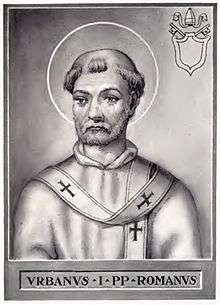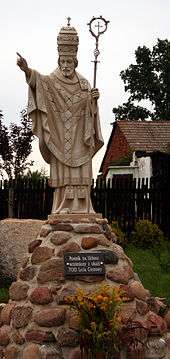Pope Urban I
| Pope Saint Urban I | |
|---|---|
 | |
| Papacy began | 222 |
| Papacy ended | 23 May 230 |
| Predecessor | Callixtus I |
| Successor | Pontian |
| Personal details | |
| Birth name | Urban |
| Born |
Unknown Rome, Roman Empire |
| Died |
23 May 230[1] Rome, Roman Empire |
| Sainthood | |
| Feast day | 25 May |
| Other popes named Urban | |
Pope Urban I (Latin: Urbanus I) was Bishop of Rome or pope from 222 to 23 May 230.[1] He was born in Rome and succeeded Pope Callixtus I, who had been martyred. It was previously believed for centuries that Urban I was also martyred. However, recent historical discoveries now lead scholars to believe that he died of natural causes.
Biography
Much of Urban's life is shrouded in mystery, leading to many myths and misconceptions. Despite the lack of sources he is the first Pope whose reign can be definitely dated.[2] Two prominent sources do exist for Urban's pontificate: Eusebius' history of the early Church and also an inscription in the Coemeterium Callisti which names the Pope.[1]
Urban ascended to the Chair of Saint Peter in the year of the Roman Emperor Elagabalus' assassination and served during the reign of Alexander Severus. It is believed that Urban's pontificate was during a peaceful time for Christians in the Empire as Severus did not promote the persecution of Christianity.[1]
Urban is a saint of the Roman Catholic Church and the Eastern Orthodox Church.
Papacy
It is believed that the schismatic Hippolytus was still leading a rival Christian Congregation in Rome, and that he published the Philosophumena, an attack on Pope Urban's predecessor Callixtus.[3] Urban is said to have maintained the hostile policy of Callixtus when dealing with the schismatic party.[1]
Due to the relative freedoms the Christian community had during Severus' reign the Church in Rome grew, leading to the belief that Urban was a skilled Converter.[3] A Papal decree concerning the donations of the faithful at Mass is attributed to Pope Urban:
"The gifts of the faithful that are offered to the Lord can only be used for ecclesiastical purposes, for the common good of the Christian community, and for the poor; for they are the consecrated gifts of the faithful, the atonement offering of sinners, and the patrimony of the needy."[4]
Tomb
It had been believed that he was buried in the Coemetarium Praetextati where a tomb was inscribed with his name. However, when excavating the Catacomb of Callixtus Italian archaeologist Giovanni de Rossi uncovered the lid of a sarcophagus which suggested that Pope Urban was in fact buried there. De Rossi also found a list of martyrs and confessors who were buried at St. Callistus', which contained Urban's name. De Rossi therefore concluded that the Urban buried in the Coemetarium Praetextati was another bishop and Pope Urban was located in Catacomb of St. Callistus. While many historians accept this opinion, doubt remains since Pope Sixtus III's list of saints buried in St. Callistus' Catacomb does not include Urban in the succession of Popes but rather in a list of foreign bishops. Therefore, it is possible that Pope Urban is indeed buried in the Coemetarium Praetextati.[3][5]
Legends and myths

As no contemporary accounts of Urban's pontificate exist there have been many legends and acts attributed to him which are fictitious or difficult to ascertain the factual nature of. The legendary Acts of St. Cecilia and the Liber Pontificalis both contain information on Urban, although of doubtable accuracy.Chaucer had him a character in his Second Nun's Tale in the Canterbury Tales.
A story that was once included in the Catholic Church's Breviary states that Saint Urban had many converts among whom were Tiburtius and his brother Valerianus, husband of Saint Cecilia. Tradition credits Saint Urban with the miracle of toppling an idol through prayer.[6] This event is believed to have led to Saint Urban being beaten and tortured before being sentenced to death by beheading.
A further belief, now known as an invention from the sixth century, was that Urban had ordered the making of silver liturgical vessels and the patens for twenty-five titular churches of his own time.
Art
Urban is found in various pieces of artwork usually in one of two forms. Often he is found sitting wearing the Papal Tiara, Papal robes and holding a sword pointed towards the ground. Otherwise Urban may be portrayed wearing Papal garb and a Bishop's Mitre while holding a bible and a bunch of grapes.[7][8] An image of Pope Saint Urbanus (or Urban/Urbain) is on a 12th-century fresco at Chalivoy-Milon in the Berry Art Gallery.[9]
Other less common depictions of Pope Urban are:
- after his beheading, with the papal tiara near him.
- as idols fall from a column while he is beheaded;
- scourged at the stake;
- seated in a landscape as a young man (Saint Valerian) kneels before him and a priest holds a book.
See also
Notes
- 1 2 3 4 5 Kirsch, Johann Peter (1912). "Pope Urban I" in The Catholic Encyclopedia. Vol. 15. New York: Robert Appleton Company.
- ↑ Kung, Hans. The Catholic Church: A Short History. New York; The Modern Library, 2003, p. 41
- 1 2 3
 Herbermann, Charles, ed. (1913). "Pope Urban I". Catholic Encyclopedia. New York: Robert Appleton Company.
Herbermann, Charles, ed. (1913). "Pope Urban I". Catholic Encyclopedia. New York: Robert Appleton Company. - ↑ Roman Breviary
- ↑ Calendarium Romanum (Libreria Editrice Vaticana, 1969), p. 124
- ↑ Roman Breviary: Saint Urban began to make his orison to God; and anon the idol fell down and slew twenty-two priests of the law that held fire for to make sacrifice.
- ↑ Portrait of Urban
- ↑ Portrait of Urban
- ↑ Image of Pope Saint Urbanus
| Titles of the Great Christian Church | ||
|---|---|---|
| Preceded by Callixtus I |
Bishop of Rome Pope 222–230 |
Succeeded by Pontian |

